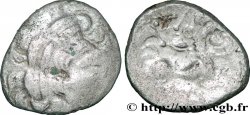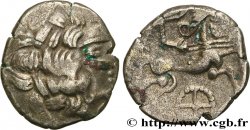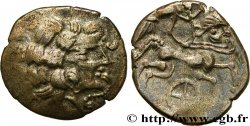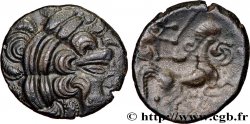bga_270845 - REDONES (Area of Rennes) Statère d’or à la cavalière armée et à la lyre - fourré et coupé en deux
Not available.
Item sold on our e-shop (2016)
Price : 180.00 €
Item sold on our e-shop (2016)
Price : 180.00 €
Type : Statère d’or à la cavalière armée et à la lyre - fourré et coupé en deux
Date: c. 200-150 AC.
Metal : electrum
Diameter : 15 mm
Weight : 3,73 g.
Rarity : R3
Coments on the condition:
Monnaie avec une découpe assez nette, fortement enganguée d’une matière sombre et lisse. Avers et revers incomplets mais identifiable malgré une frappe un peu molle
Obverse
Obverse legend : ANÉPIGRAPHE.
Obverse description : Restes de tête laurée à droite.
Reverse
Reverse legend : ANÉPIGRAPHE.
Reverse description : Cavalière à droite, brandissant un bouclier et une épée ; entre les jambes du cheval, une lyre accostée d’une croisette bouletée.
Commentary
Ce statère semble pouvoir être rapproché du statère à la cavalière armée et à la lyre. Il semble être fourré, l’âme du métal étant particulièrement visible au niveau du coup de burin, à moins que le métal des dernières séries soit fortement allié de cuivre.
Si le phénomène de couper des monnaies en deux pour en faire des divisionnaires est bien attesté pour les monnaies de bronzes (as de Nîmes) et pour les potins, il nous semble que ce soit beaucoup plus rare pour les statères.
Comme pour le bga_270844, l'inexistence d’hémi-statère ou leur extrême rareté a pu motiver la découpe de cette monnaie. A moins qu’il s’agisse d’une démonétisation ou encore d’un morceau de métal destiné à la refonte....
Si le phénomène de couper des monnaies en deux pour en faire des divisionnaires est bien attesté pour les monnaies de bronzes (as de Nîmes) et pour les potins, il nous semble que ce soit beaucoup plus rare pour les statères.
Comme pour le bga_270844, l'inexistence d’hémi-statère ou leur extrême rareté a pu motiver la découpe de cette monnaie. A moins qu’il s’agisse d’une démonétisation ou encore d’un morceau de métal destiné à la refonte....








 Report a mistake
Report a mistake Print the page
Print the page Share my selection
Share my selection Ask a question
Ask a question Consign / sell
Consign / sell
 Full data
Full data



